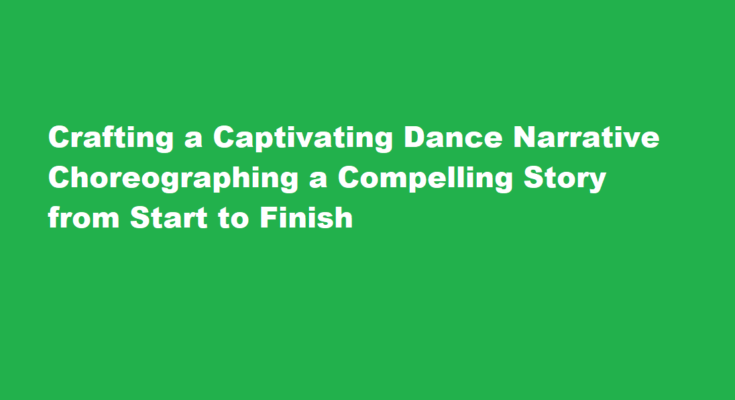Introduction
Dance is a powerful form of expression that goes beyond mere movement. When a dance routine tells a compelling story from beginning to end, it captivates the audience and leaves a lasting impact. Choreographing such a narrative requires a careful blend of creativity, emotion, and technicality. In this article, we will delve into the steps and techniques involved in crafting a dance routine that weaves a captivating story, drawing the audience into a world of emotions and enchantment.
Choose an Engaging Theme or Concept
The foundation of a captivating dance routine is a compelling theme or concept. Select a theme that resonates with your emotions and evokes a story that you are passionate about conveying. It could be a personal experience, a historical event, a piece of literature, or even an abstract emotion. The key is to choose something that sparks creativity and enables you to explore a range of emotions through your choreography.
Develop a Strong Narrative Arc
Every captivating dance routine needs a well-structured narrative arc. Just like in storytelling, it should have a clear beginning, middle, and end. The beginning introduces the characters and sets the stage, the middle delves into the conflicts and emotions, and the end brings resolution or transformation. Ensure that each section of the routine flows seamlessly into the next, creating a cohesive and engaging story.
Embrace Choreographic Elements
Choreographic elements like movement, space, timing, and dynamics play a pivotal role in conveying emotions and building a compelling story. Use a variety of movements that suit the theme, and blend different dance styles if appropriate. Utilize the entire performance space to create visually striking formations and transitions. Master the art of timing, incorporating pauses and dynamics to emphasize critical moments in the narrative. Remember, the beauty of a compelling story lies in the details of the choreography.
Connect with Your Dancers
As a choreographer, it’s essential to connect with your dancers on a personal level. Discuss the narrative’s emotional depth and character development with them. Encourage them to invest emotionally in the story, bringing their unique interpretations to their movements. This connection between the choreographer and the dancers will add authenticity and depth to the performance, further captivating the audience.
Use Music as a Storytelling Tool
The choice of music can make or break a dance routine’s storytelling capabilities. Select music that complements the theme and enhances the emotional impact of each scene. The tempo, rhythm, and melody should align with the narrative arc, intensifying the emotions felt by both dancers and spectators. Use musical cues to signal shifts in the storyline or to emphasize crucial moments, creating a cohesive experience that resonates with the audience.
Experiment with Costume and Set Design
Costumes and set design are essential elements that help transport the audience into the world of the dance routine. Experiment with costume choices to reflect the characters’ personalities or the mood of the narrative. Similarly, the set design should complement the overall theme, providing visual cues that enhance the storytelling. These visual elements will add depth and dimension to the performance, drawing the audience even deeper into the captivating narrative.
FREQUENTLY ASKED QUESTIONS
How do you tell a story through a dance?
There should be a beginning, a middle and an end to the dance that people can follow when watching. Sections of the dance can act like chapters of the story, breaking it down into smaller chunks and highlighting the most important things that are happening.
What is a story dance called?
Kathakali ( IAST: Kathakaḷi Malayalam: കഥകളി) is a major form of classical Indian dance. It is a “story play” genre of art, but one distinguished by the elaborately colourful make-up and costumes of the traditional male actor-dancers.
Conclusion
Crafting a dance routine that tells a compelling story is a challenging yet rewarding endeavor. By selecting a compelling theme, developing a strong narrative arc, embracing choreographic elements, connecting with your dancers, using music thoughtfully, and experimenting with costume and set design, you can create a mesmerizing dance experience that leaves a lasting impression on your audience.
Read Also : Spreading Joy and Positivity How to Plan and Execute a Community-Wide “Random Acts of Kindness” Day



